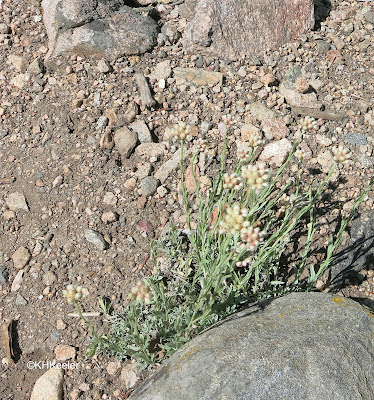Pussytoes (Antennaria species, sunflower family, Asteraceae) are cute little plants, easy to recognize when flowering, inconspicuous when they are not. There are about 45 species of Antennaria, mostly in North America plus a few in Europe and South America. The U.S.D.A. plants database gives 36 species of Antennaria in North America, counting Alaska, all of them native.
 |
| Antennaria pussytoes |
When flowering, they send up clusters of round flowers, easily imagined as cat feet. (Catsfoot is another common name). The non-flowering plant is a cluster of quite small oval gray-green leaves on the ground, often below the grasses, and so quite inconspicuous.
 |
| pussytoes, Antennaria |
 |
| rosy pussytoes, Antennaria rosea |
Plants are dioecious, with male plants that produce only pollen and females that produce the seeds. They spread vegetatively into good sized clones, so can endure for years or decades if there is no plant of the other sex nearby. (Waiting patiently for a mate to show up?) In addition, some species are apomictic, producing seeds even if the flowers are not pollinated.
Pusssytoes are quite variable in size, shape, and color and will hybriidize betwen species, so are often difficult to identify. My photos are of species seen in Colorado and Nebraska. The pinkish one is probably rosy pussytoes, Antennaria rosea, since no other species in my area is as distinctly pink.
Other common names for Antennaria species are everlasting (also used for other plants including Anaphalis), lady's tobacco (and woman's tobacco), dog toes, four toes, love's nest, and white plantain.
Native Americans across the continent used pussytoes medicinally for ailments, from treating swelling and pain, speeding healing after childbirth, and as a mouthwash for toothaches (using the roots). Settlers placed pussytoes in stored woolens to discourage moths. A decoction of pussytoes was added to shampoo to remove lice. Young flowering tops in tea are astringent and diretic and since the tea has a pleasant flavor it was used to treat for children's fevers and colds.
 |
pussytoes, Antennaria
Leaves of one species, Antennaria parviflora, were eaten as green vegetables by the Navajo in Arizona, whiile other tribes sometimes chewed other species of pussytoes just for the flavor and texture.
I can find little in the sources available to me about western European medicinal uses of Antennaria, but A. dioica is common across Eurasia (and into Alaska), and it was used for stomach and respiratory ailments in eastern Europe and western Asia. It contains astringent, antibacterial, and antifungal compounds, but their efficacy as medicine has received little modern attention.
Pussytoes' flower clusters dry easily, so, since at least Elizabethan times, they have been used dried in dried flower arrangements.
 |
| Pussytoes with seed heads |
A variety of birds and mammals eat the foliage and flowers. The plants are too small and scattered to be a major part of the diet of most animals. The seeds are truly tiny and probably consumed with the flower heads but not a target of seed-eating birds or mice. However, pussytoes are host plants to the butterflies American lady (Vanessa virginiensis) and painted lady (Vanessa cardui), their caterpillars happily eat the leaves and flowers.
These are interesting and attractive little plants that we too often walk past
Comments and corrections welcome.
References
Babotă M, A. Mocan, L. Vlase, O. Crișan, I. Ielciu, AM Gheldiu, DC Vodnar, G. Crișan, and R. Păltinean. Phytochemical analysis, antioxidant and antimicrobial activities of Helichrysum arenarium (L.) Moench. and Antennaria dioica (L.) Gaertn. Flowers. Molecules. 2018 Feb 13;23(2):409. doi: 10.3390/molecules23020409. link Accessed 6/16/24.
Borge, M. A. 2015. Pussytoes and butterflies. The Natural Web. https://the-natural-web.org/2017/05/15/pussytoes-and-butterflies/ Gorgeous photos.
Kindscher, K. 1992. Medicinal Wild Plants of the Prairie. University of Kansas Press, Lawrence, KS.
Moerman, D. E. 1998. Native American Ethnobotany. Timber Press. Portland, Oregon.
O'Brien, M. and K. Vail. 2016. Edible and medicinal plants of the Southern Rockies. Learning Tree Tales.
Sanders, J. 1993. Hedgemaids and Fairy Candles. The Lives and Lore of North American Wildflowers. Ragged Mountain Press, Camden, Maine.
Smith, J. R. and B. S. Smith. 1980. The Prairie Garden. University of Wisconsin Press, Madison Wisconsin.
Kathy Keeler
A Wandering Botanist
More at awanderingbotanist.com
Join me on Facebook: https://www.facebook.com/AWanderingBotanist

No comments:
Post a Comment